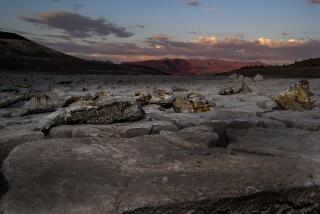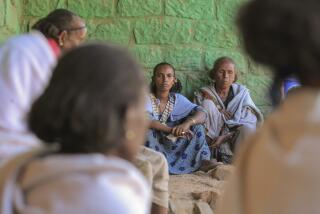Australian drought saps small towns
- Share via
POOCHERA, AUSTRALIA — Glen Phillips kneels down, scoops up a handful of dirt and squashes it in his fist to test whether the soil in this dry patch of the Australian Outback is ready to take a crop of wheat.
“It should clump together when you squeeze,” says Phillips, whose family has lived off the land on the edge of the Great Australian Bight since 1949. “That’s how you know it’s good to plant, it’s moist enough to hold the roots.”
He opens his hand and the earth sifts dustily between his fingers. Phillips looks up, lifts his hat slightly and squints into an empty blue sky with no sign of rain.
“We’ll plant anyway,” he says. “We don’t have a choice.”
Australia is suffering one of its worst droughts on record, hurting wheat farming just as the world faces a food crisis. Australia is usually the world’s third or fourth-largest exporter of wheat. But exports dropped 46% from 2005 to 2006, then fell 24% last year.
Most of its exports go to the Middle East and Southeast Asia to make bread and cereals, but the fall in supply has led to soaring prices. A ton of Australian wheat costs $367, compared with $258 in early 2007, an increase poorer countries can ill afford.
“When they pay high prices, they pass on an increase to their poorest people, who can no longer afford it,” says Kunhamboo Kannan, director of agriculture, environment and natural resources at the Asian Development Bank. “Just look at Egypt.” Riots over rising bread prices and shortages have led to at least 10 deaths there this year.
Relief may be on the way. Wheat sowing rose by 13% this year, according to the Australian Bureau of Agriculture and Research Economics, because of rainfall in the eastern part of the wheat belt and dry-planting elsewhere. And if all goes well, the 2008 wheat harvest could be close to normal at 23.7 million tons, compared to 13 million last year.
But it all depends on whether the rain comes, and experts say it will be months before they know how the current crop of wheat will fare. In any case, stocks are low after several years of drought in a row.
Poochera is one of dozens of one-pub towns on the Eyre Peninsula where grain silos are the tallest buildings and there are just enough stores to supply the surrounding farms. Another year without rain would be the third in a row, and this May was the country’s driest on record.
The peninsula, a giant wedge of land jutting into the ocean off southern Australia, forms part of a narrow crescent known as the wheat belt that includes some of Australia’s most arable land. It is also among the hardest hit by the drought.
The drought has made it harder to grow anything, from wheat to rice to corn.
Phillips says good wheat crops can grow with next to no rain. The problem is, he’s been getting less than that.
In 2006, after promising autumn downpours, the rain stopped in winter and Phillips watched his crop die. The same thing happened last year, although he managed to scrounge about one-third of what the land produces in a good year.
In two years, he estimates, the drought has cost him more than half a million dollars. This season he had to take out a loan for the first time to cover the costs of planting and feeding his livestock.
Elsewhere in Australia, recent rains have led to hope the drought is easing, but the relief is patchy and it will take time to restore former production levels. According to Australia’s Bureau of Meteorology, most of the country received below average or “very much below average” rainfall from March 1 to May 31, the sowing months.
In the Eyre Peninsula, about 400 miles west of the South Australian state capital of Adelaide, some farmers have chosen to skip the entire winter wheat-growing season rather than gamble on loose, dry subsoil and the merest chance of rain. The cost of planting -- seed, fertilizer, weedkillers -- is about $60 an acre, not counting wages.
Here in the sprawling Outback properties, where land is abundant and water scarce, many farmers own sheep and cattle as well as crops to spread their risk. It’s not quite a hand-to-mouth existence, but it’s getting close.
Phillips, 55, took over this property 34 years ago from his father. He farms wheat and barley and raises sheep and cattle with his sons, Darcy and Ashley.
His family has not earned wages since 2006. The farm pays just the expenses of running the property and the house. His wife, Kathy, keeps an expansive vegetable garden that feeds the family year-round, and they slaughter ducks, lambs and cows to eat.
Anything else is a luxury until they can earn from their crops again.
For the last two years, livestock carried them through. Wool from the sheep brought high prices, and the first year they raised lamb and calves to near maturity before selling them for a good price.
But last year they were forced into an early and cheap sell-off of 2,500 lambs and more than 50 young calves to keep afloat.
With no new income, the family has already paid more than $11,000 for cattle feed this year. Expenses such as weedkiller and diesel costs are soaring. Fertilizer is up 30%.
The family is gambling on a successful crop.
“If you don’t put it in the ground, you don’t have a chance,” Darcy Phillips says.
They are dry-planting 4,500 acres of wheat and 1,500 acres of barley and praying for enough moisture in the coming weeks to “shoot the grain,” or let the roots take hold in the soil. They will then hold their breath until spring, when the crops will need even more rain to grow to maturity before a late-November harvest.
If not, the family faces a bleak choice. The last two years, Darcy left the farm before spring to work on a ranching station. He might have to take a longer-term and higher-paying job at the gold mines, as many of his generation are already doing.
Ashley, who has a wife and toddler at home, will have to search for work closer to home. The fields will probably lie fallow.
The problems are common in Poochera and throughout the region. The local school has shrunk from 170 students a decade ago to just 90, livestock agents have left, businesses have shut down and the closest doctor is now more than 50 miles away.
“As every drought goes on -- it’s just another nail in the coffin to a small country town out here,” Darcy Phillips says.
His father nods and contemplates adding the family to the outward procession. “Even if this year is an average year I reckon there will be a lot of people sell out or get out, and we might be one of them,” Phillips says. “It’s just getting too hard.”
More to Read
Sign up for Essential California
The most important California stories and recommendations in your inbox every morning.
You may occasionally receive promotional content from the Los Angeles Times.










